1.0 Software
1.1 The Concept
This project is my entry for the 2021/22 Student Design Awards by the Royal Society of Arts(RSA).
The RSA Brief:
How might we apply circular economy principles to increase and encourage the reuse of steel from decommissioned oil platforms to reduce carbon footprint, retain material value and stimulate the local economy?
My Project Proposal
Opposed to the above, in my view it is better to focus on long-term gains rather than quick profiting. Fish populations are collapsing due to issues such as overfishing coral bleaching and alike. Therefore, the decommissioned platforms can be used as artificial reefs providing shelter and food for marine animals. By making these areas protected free from fishing their effectiveness may be further improved.
1.2 Approach
Throughout the project one of my primary goal was to focus and adhere to the United Nations Sustainibility Development Goals(STGs) through a human centered design. The STGs are 17 distinguished but interconnecting goals set by the UN serving as a blueprint to achieve a better and more sutstainable future for all. (1.2.1) I am proud to be part of an institution such as the University of Winchester where attention is centered around sustainibility and environmental issues therefore, it felt imperative that my design approach mirror these principles. Although the project converges around goal 14 - Life Below Water - there is an intricate connection between all STGs.

1.2.1 image sourced from unemg.org

1.2.2 image sourced from idea.org
1.3 Parallel Projects & The Design Process
The RSA project diverges into two separate yet correlating assignments by two university modules. One is a Case Study involving the culmination of extensive primary and secondary research based on scientific evidence an peer reviewed articles and jurnals. As such defining the 'problem' the first step of the design process. The second assignment -subject of this project- is the proposed 'solution' often relies on the case study yet it is also based on months of research and 3D work.In order to determine a viable solution it is important to gain holistic understanding of the issue first.
1.4 The Problem
The oceans cover 71% of the Earth's surface. Possibly the unfathomable size responsible for the obscurity of marine issues within the greater populus. Yet these problems cannot be overlooked any longer. Throug my research I aquired first-hand knowledge just how severe the present situation and gained insight to worrying future predictions based on current trends and state of the art computer modelling.
Clean and healthy oceans are essential to humanity's long term survival. They govern the climate, drive weather patterns, generate most of the oxygen, feed and employ billions worldwide. Beside pollution the two main marine concerns are overfishing and coral bleaching. The following images offer a modest insight into these issues.
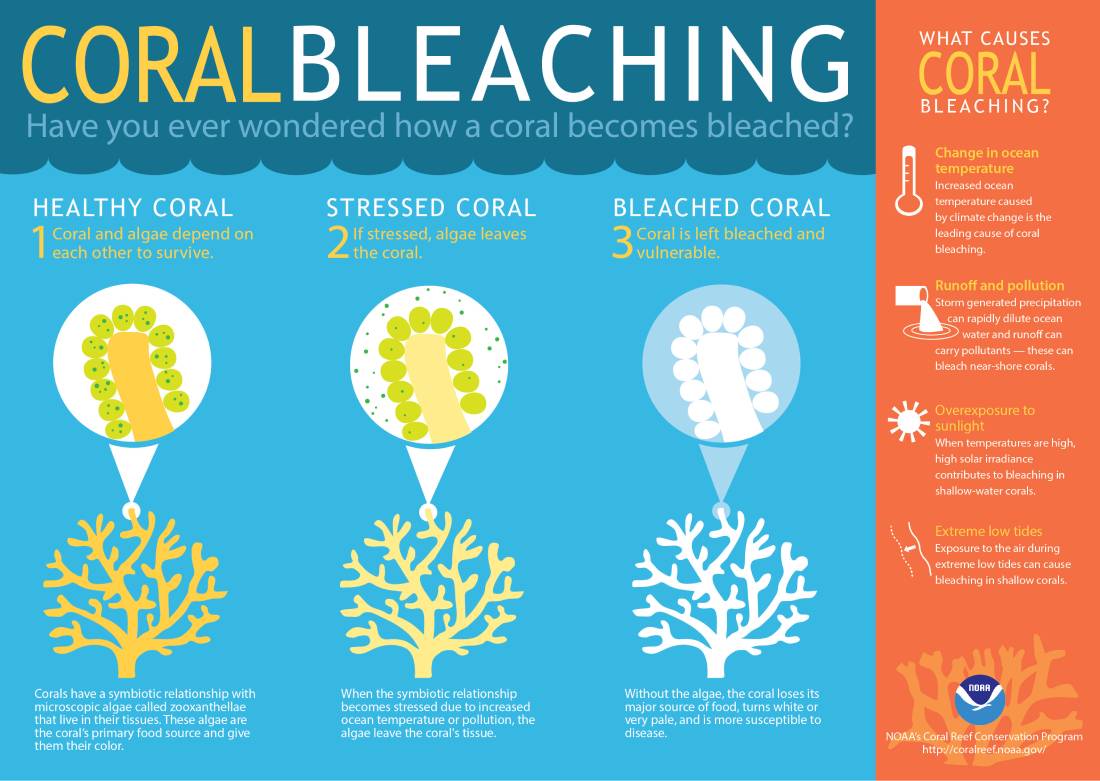
1.4.1 image sourced from oceanservice.noaa.gov
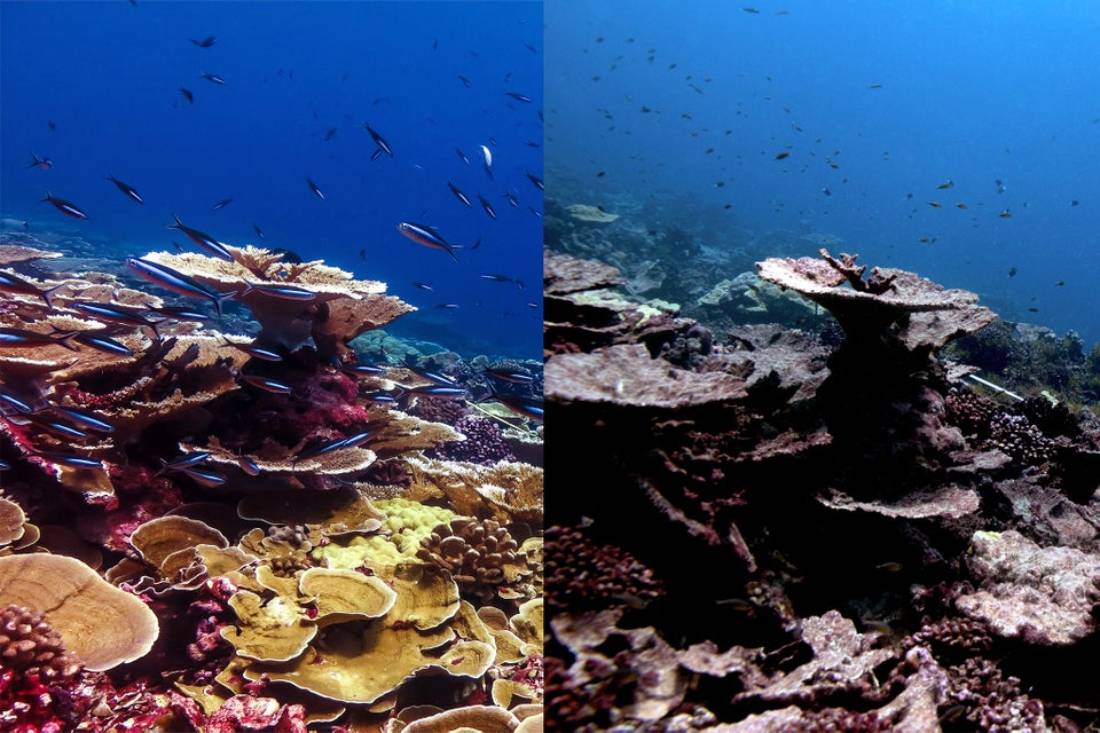
1.4.2 Before - After Coral Bleaching at Christmas Island, Kiribati 2015 then 2016. image sourced from reddit.com
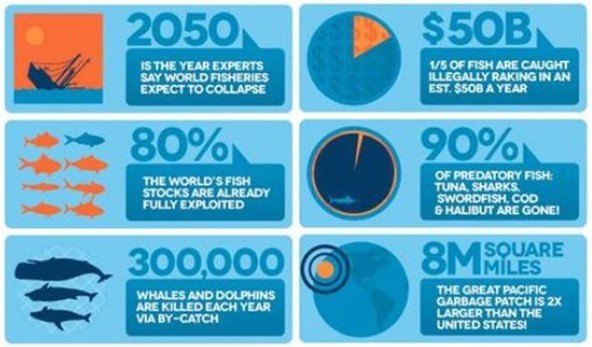
1.4.3 Overfishing Stats and Predictions. image sourced from reefci.com
1.5 The Current Situation
Since the late 19th century, the petroleum industry powered humanity’s transport and energy need. Today over 12000 offshore oil and gas production platforms fulfill most of this demand worldwide. (Gerretsen, 2021) The era of fossil fuels however is nearing the terminus point. The change of attitude towards the progressively eminent environmental issues in addition to public and political concerns presenting increased pressure on the energy sector. With the emergence of innovative and affordable green technologies energy suppliers began shifting to renewable sources therefore the future of oil and gas rigs are in question.

1.5.1 Status Quo
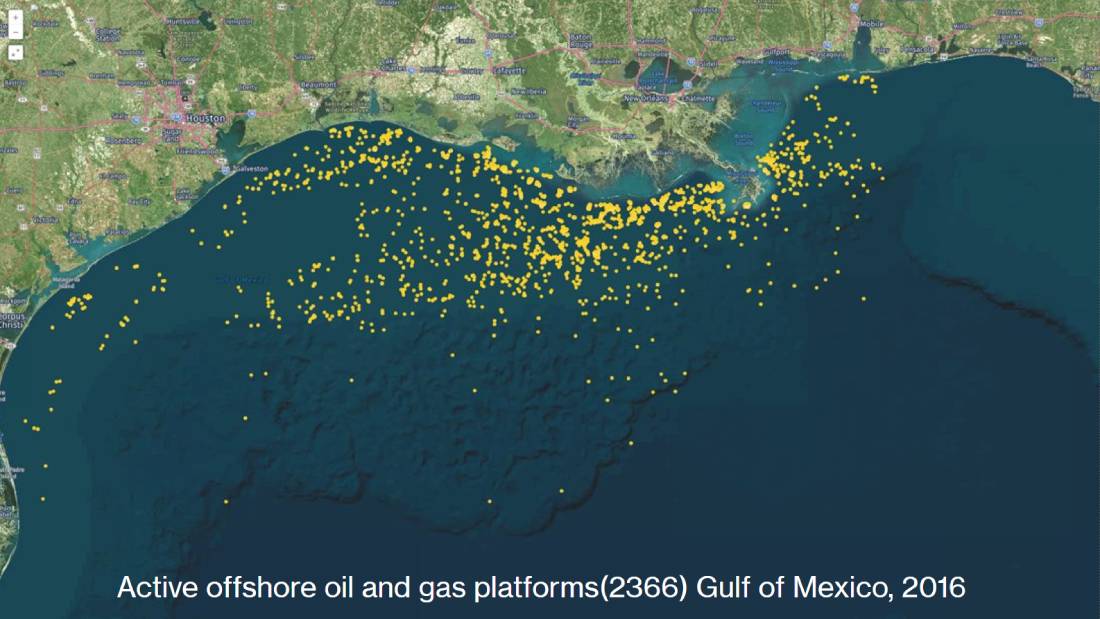
1.5.2 Over 1/5 of all active offshore oil/gas rigs are located in the Gulf of Mexico area. image sourced from skytruth.org
1.6 The Solution
The results of my case study research clearly showed that the Rigs to Reef(R2R) initiative is a feasible solution.
What is Rigs to Reef?
Once an offshore oil or gas platform stops producing at economic rates it gets decommissioned, towed to shore, and eventually disassembled. The Rigs to Reef program offers an alternative solution often called reefing by modifying the structure to support marine life as an artificial reef. (Blue, 2014) (1.6.1)
My aim is to accelerate the Worldwide Implementation of the Rigs to Reef procedure by creating suitable marketing materials such as RSA boards and a brief animation based on 3d imagery therefore raising awareness and influencing stakeholders.(1.6.2)
Marine species, including fish, find the structure immediately. Settlement by invertebrates is well established within a month, and after six months to a year, the site is well established as an artificial reef. (Texas.gov, 2021) The Baram-8 platform is an excellent illustration of the effectiveness of the R2R method.(1.6.3)
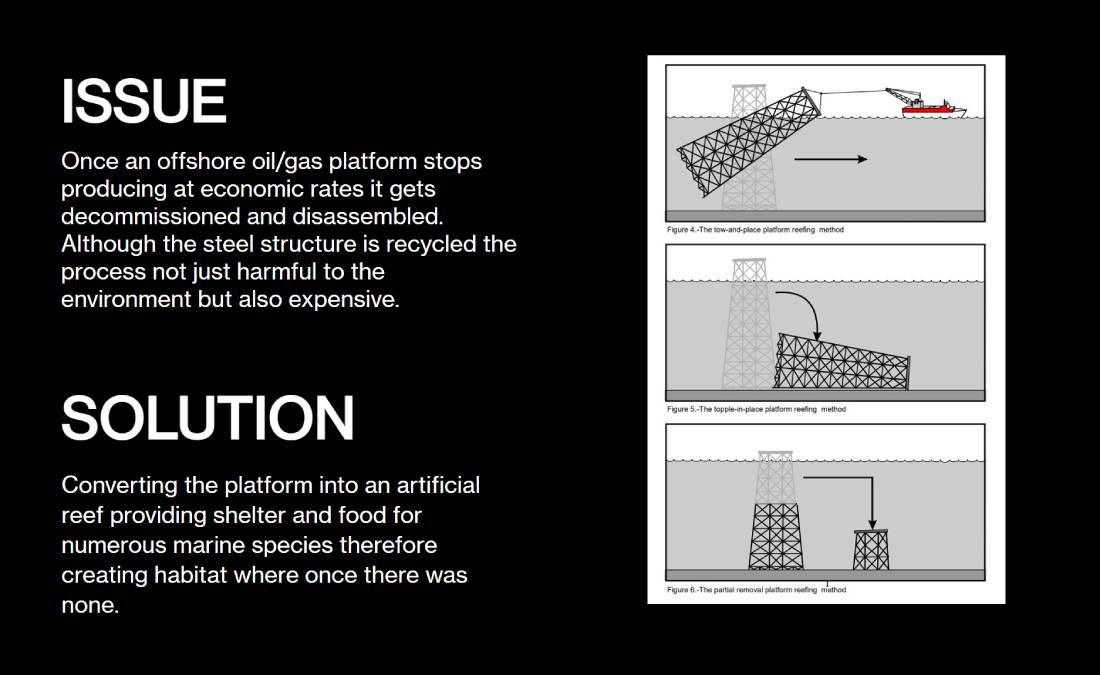
1.6.1
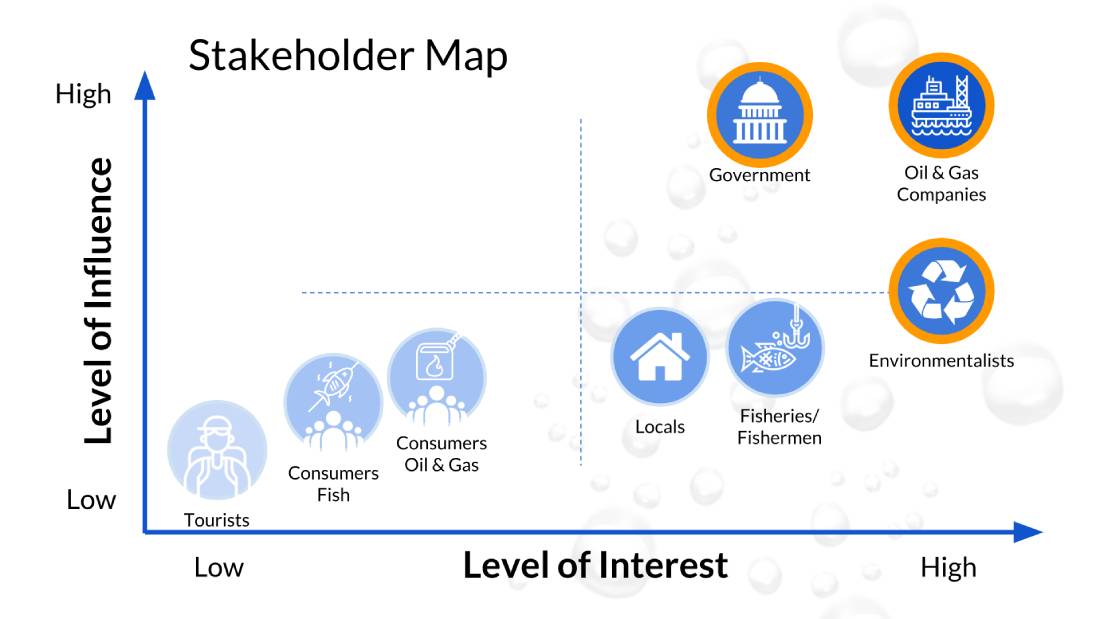
1.6.2 image sourced from finalteamproject50.home.blog
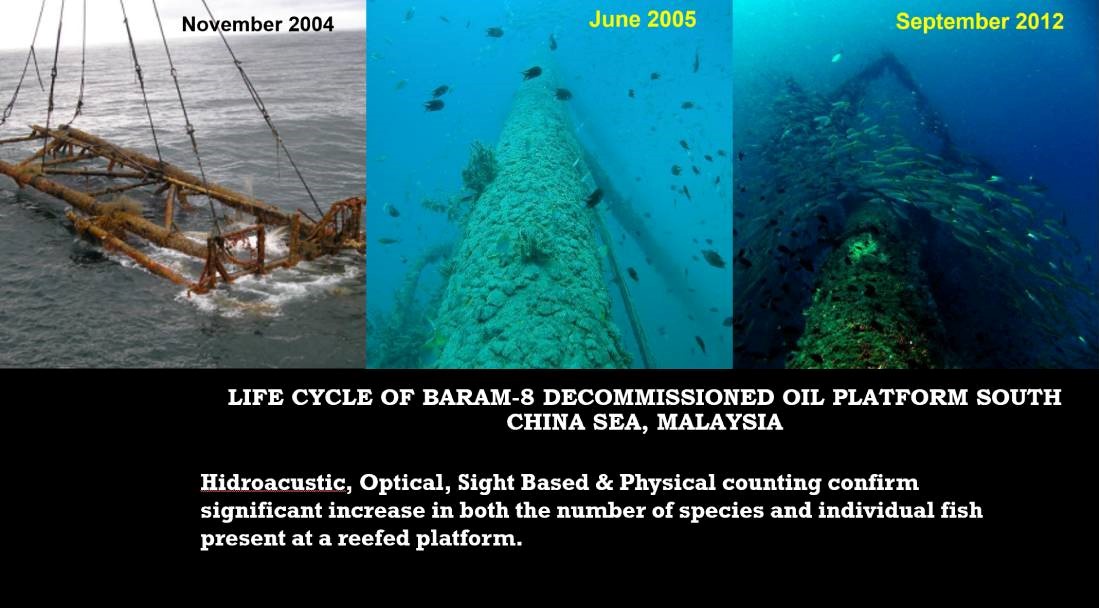
1.6.3
1.7 Structuring
1.8 The Seafloor
1.9 The Ocean
I really wanted to create a realistic looking ocean. As light wavelength decreases from red to blue light, so does the ability of light to penetrate water. With increasing depth colours quickly fade out until only black remains. The tiny particles in the water also reduce visibility. To recreate this phenomenon the following steps were taken.(1.9.2)
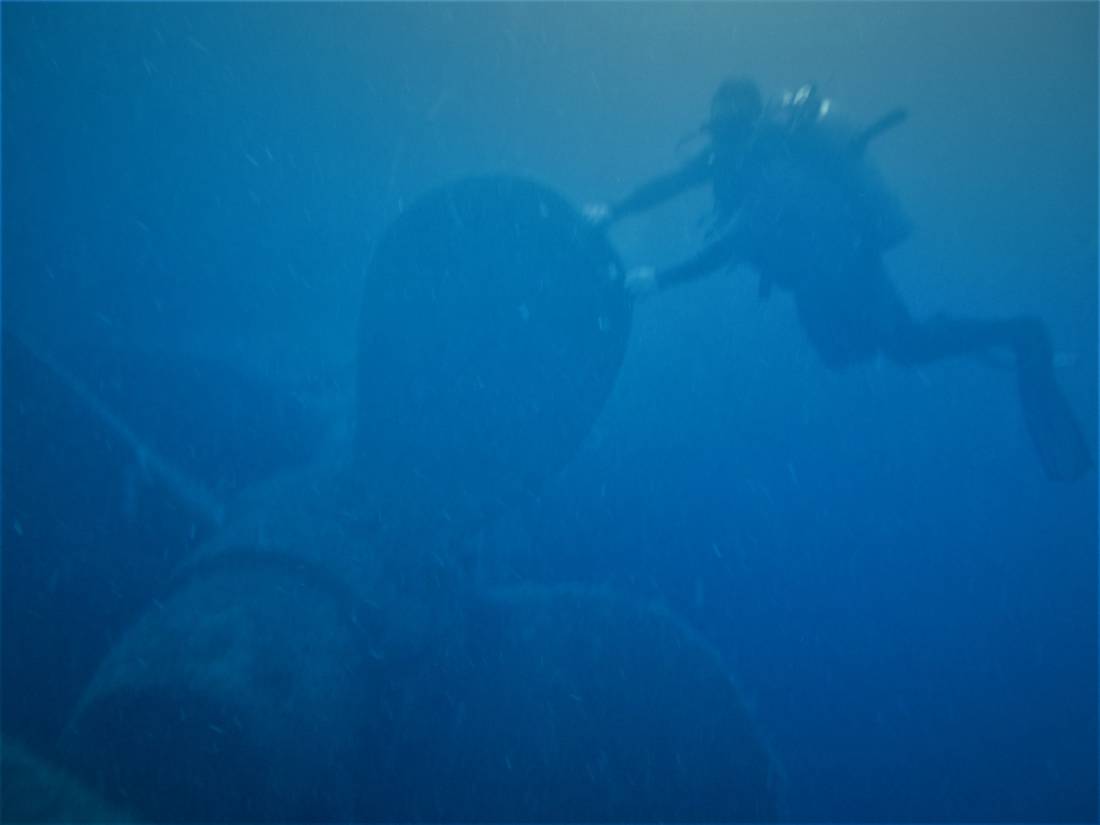
1.9.1 Colours absorbed as depth increases. MS Zenobia, Cyprus at approx 25-27m
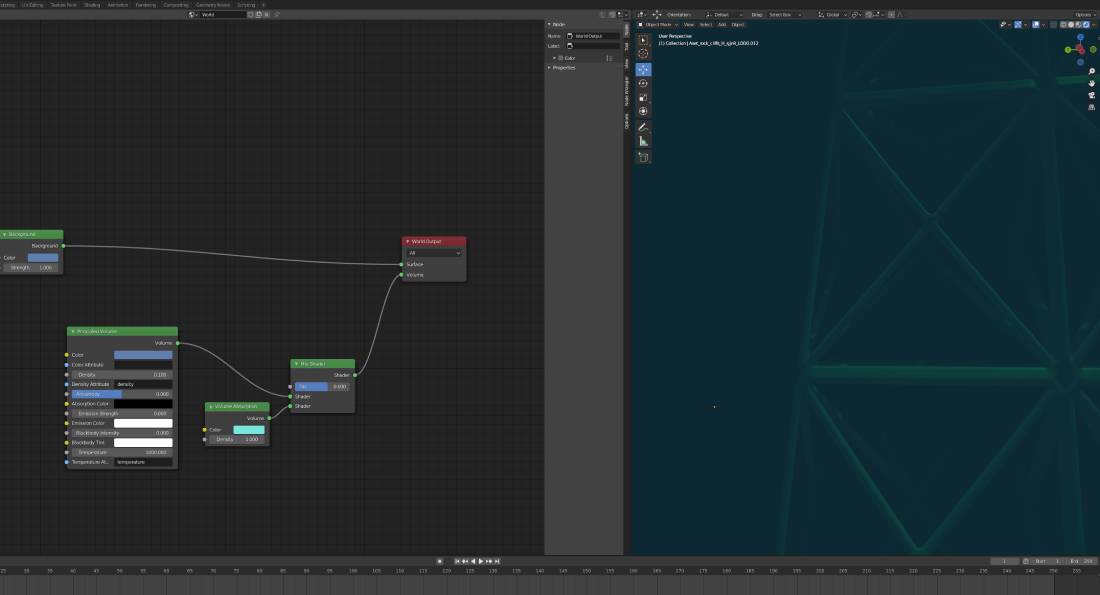
1.9.2
2.0 The Fish
I specifically wanted to model some reef fish such as barracudas, yellow and blue tangs as they are always found around reefs.(2.0.1) I followed the almost the same steps for each species. (2.0.2) First I traced the reference image, made holding edges, extruded all faces. Then applied a mirror modifier and selected shade smooth. Added a new material from the image texture. To unwrap to the required shape I selected un-wrap project from the view tab. The following step only apply to the barracudas as they have rough scales. To reach the desired effect I added a color ramp and connected to the roughness of the Principled BSDF and added another color ramp plus a displacement node to the displacement of the material output. Experimenting with color positions granted the final effect. (2.0.3)
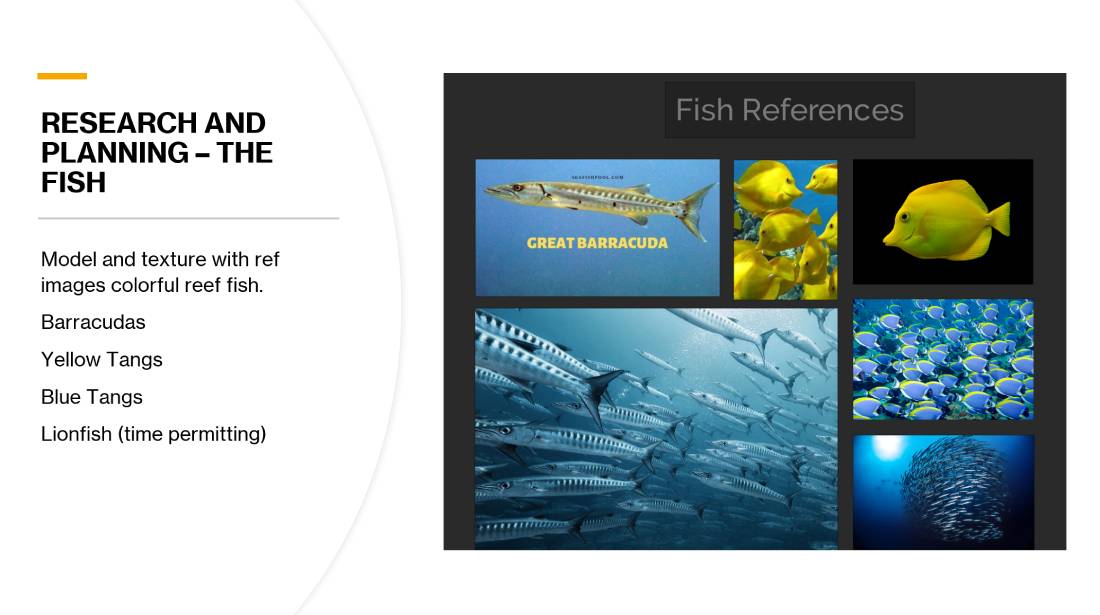
2.0.1

2.0.2
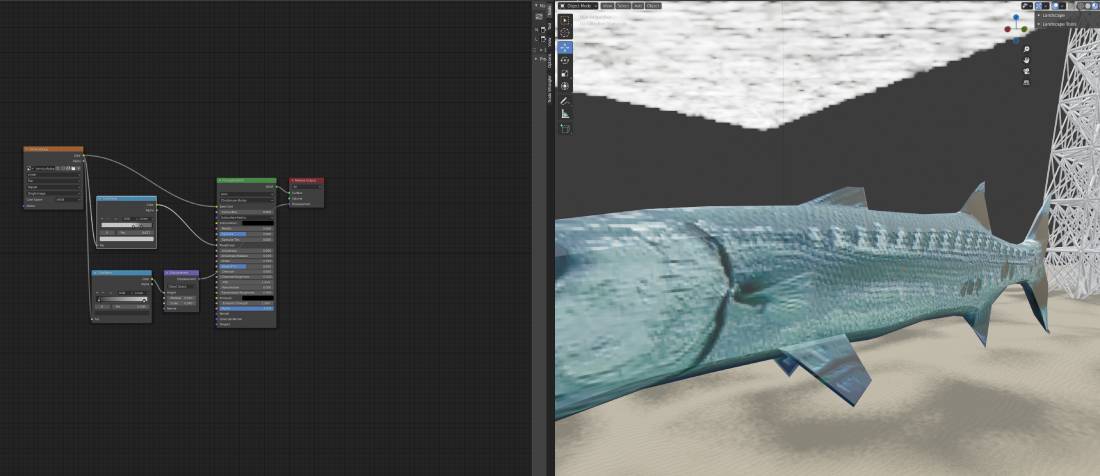
2.0.3
2.1 The Seaweed
I imported all seaweed from Megascans. I added them to new collections according to their location in the scene as some were on the seafloor some on the rig. This way I could associate them to the respective particle systems at a later stage. Since I appliy a wave modifier in order to make them sway for the animation the bottom vertices had to be pinned down to the seafloor allowing only the mid and upper part to moved. The wave modifier required some fine-tuning. In the end the following settings worked best. Set Hight to 8m, Width to 0.61 Narrowness to 0.82 and speed to 0.4. Varying these numbers a bit resulted in a more realistic and diverse look. (2.1.1)
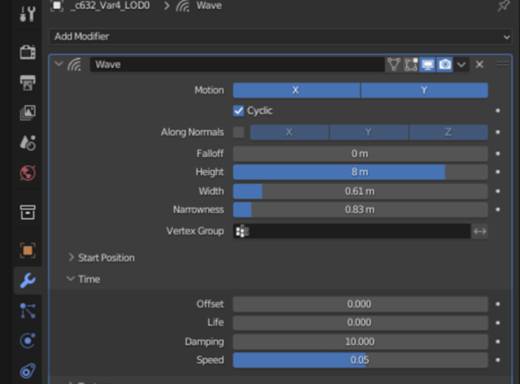
2.1.1
2.2 Populating the Seafloor
To realisticly populating the seafloor with seaweed and rocks I useed Blender's built in particle system. In particle properties I added a hair particle system to the seafloor. Modified the render As from Path to Collection. Next I changed the instance collection to SeaFloorSeaweed Collection. Scale and randomness was adjusted for the sake of diversity. In order to stop objects floating above the plane surface object origins needed adjustment. (2.2.1)
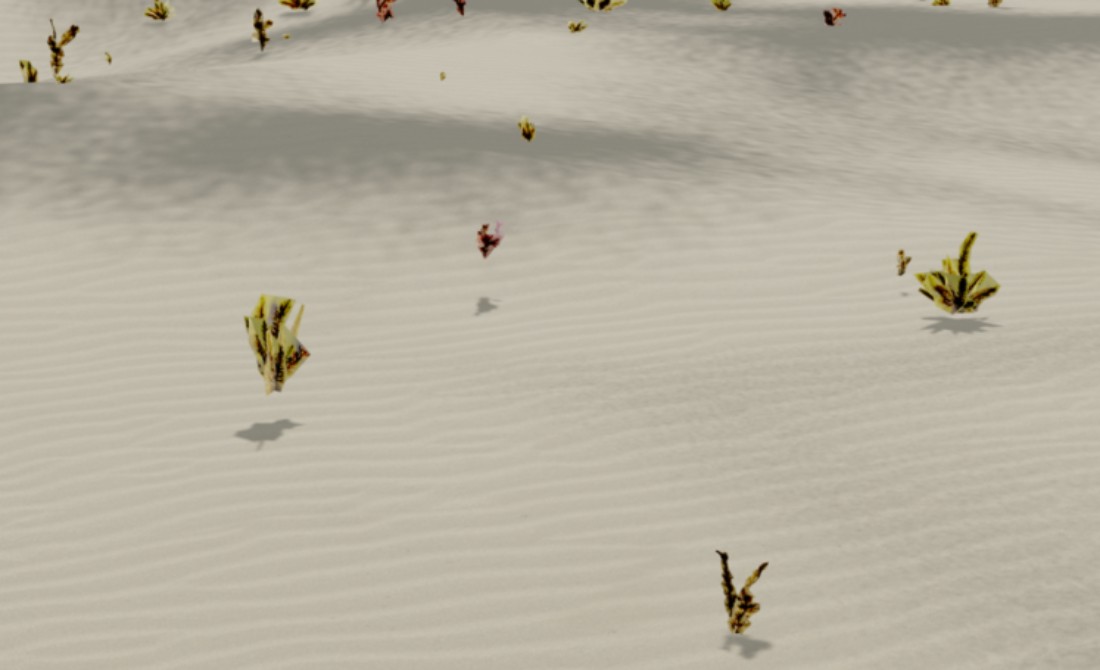
2.2.1
2.3 Modelling the Holding Structure
Conspicouos from the first sight of the reference images the sheer size of the holding structure. (2.3.1) One obstacle I faced when modelling the structure is a distortion that occured when I wanted to scale the whole structure at certain points evenly. By the advice of my lecturer I used the lattice modifier that yielded the desired shape. (2.3.2)
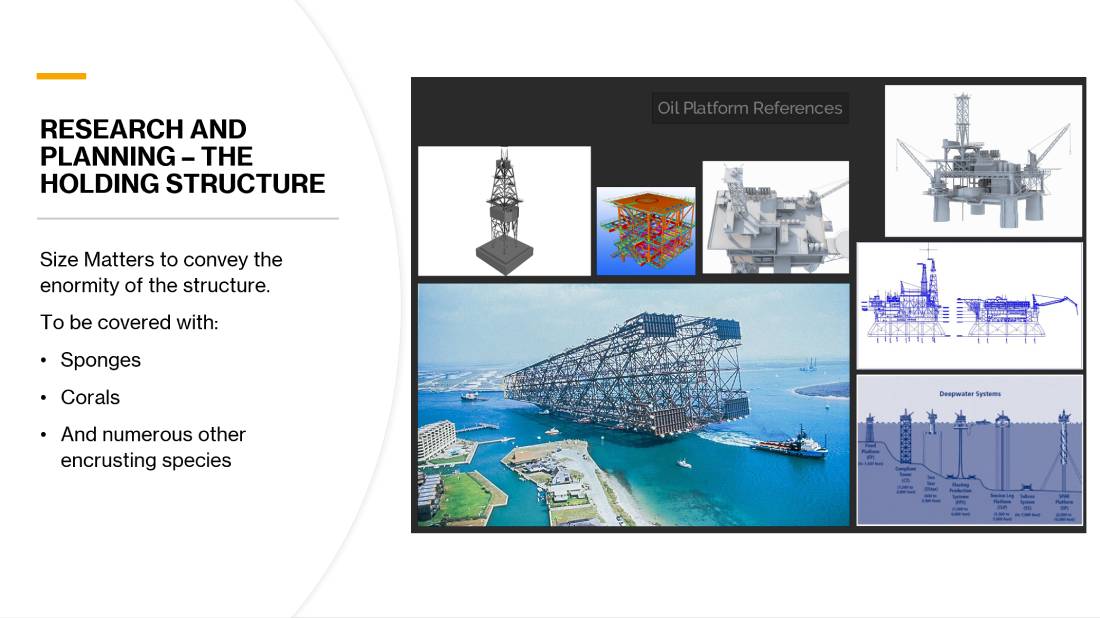
2.3.1
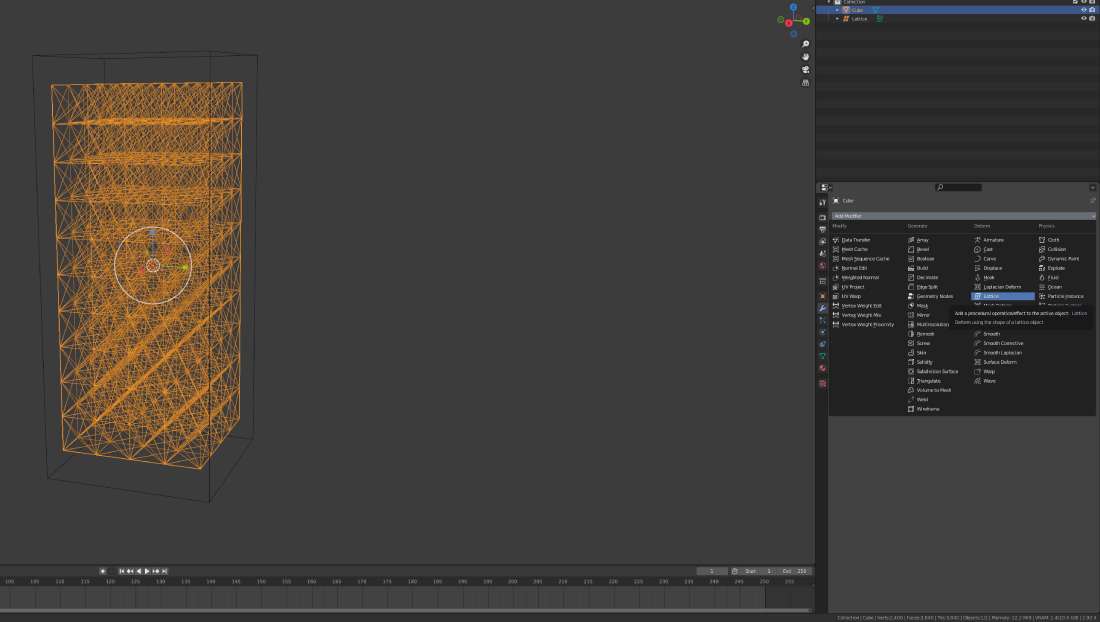
2.3.2
2.4 Modelling the Submarine
I struggled with modelling inspiration and outcome. I overcome this by getting more relevant sub ref images and diviating less from them. (2.4.1) Started 3-4 different models initially but some got influenced too much by spaceships(maybe use them in a future project). (2.4.2, 2.4.3) A scientific sub needs robotic arms and all sorts of industrial looking tools. (2.4.4) The propeller creation process is demonstrated on the last four images. (2.4.5 - 2.4.8)
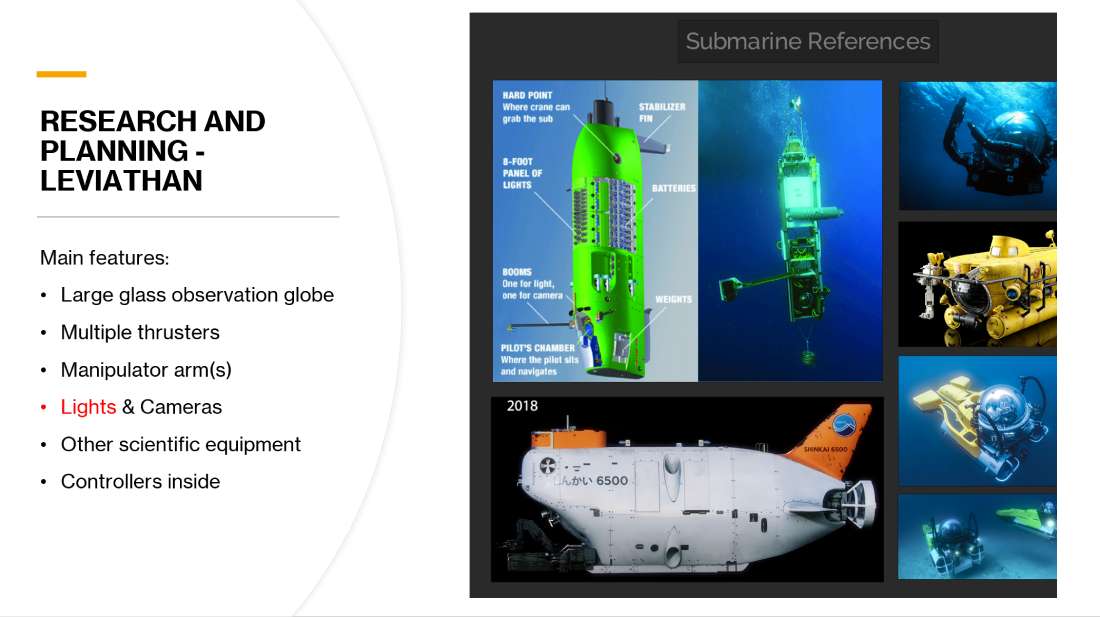
2.4.1
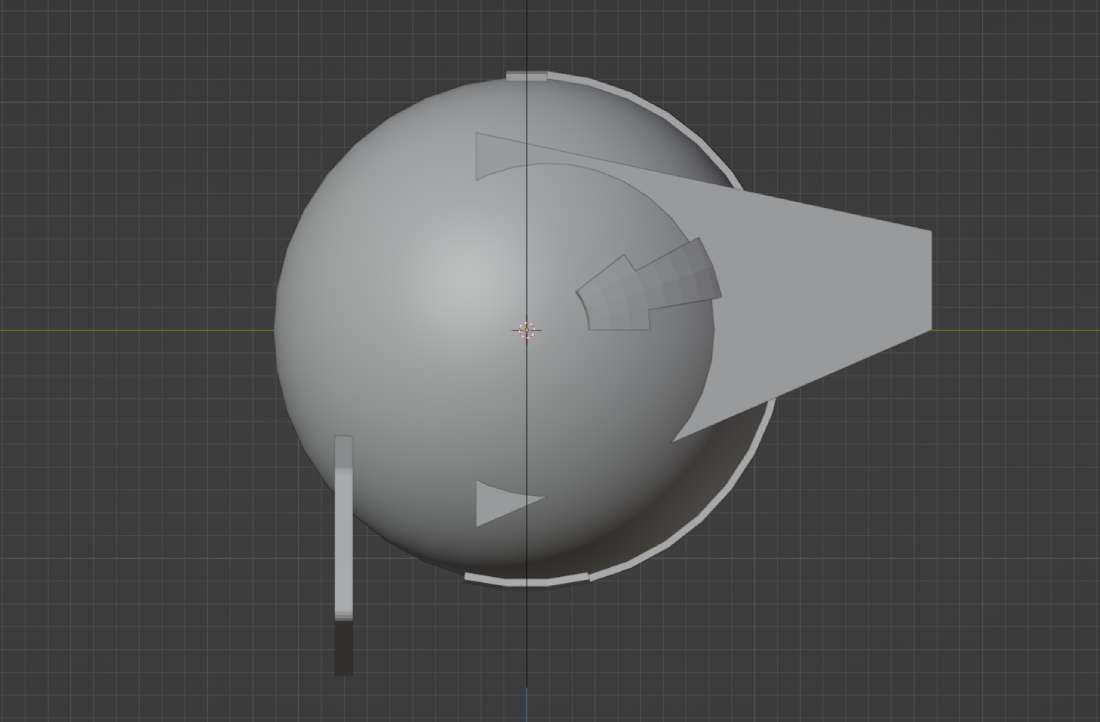
2.4.2
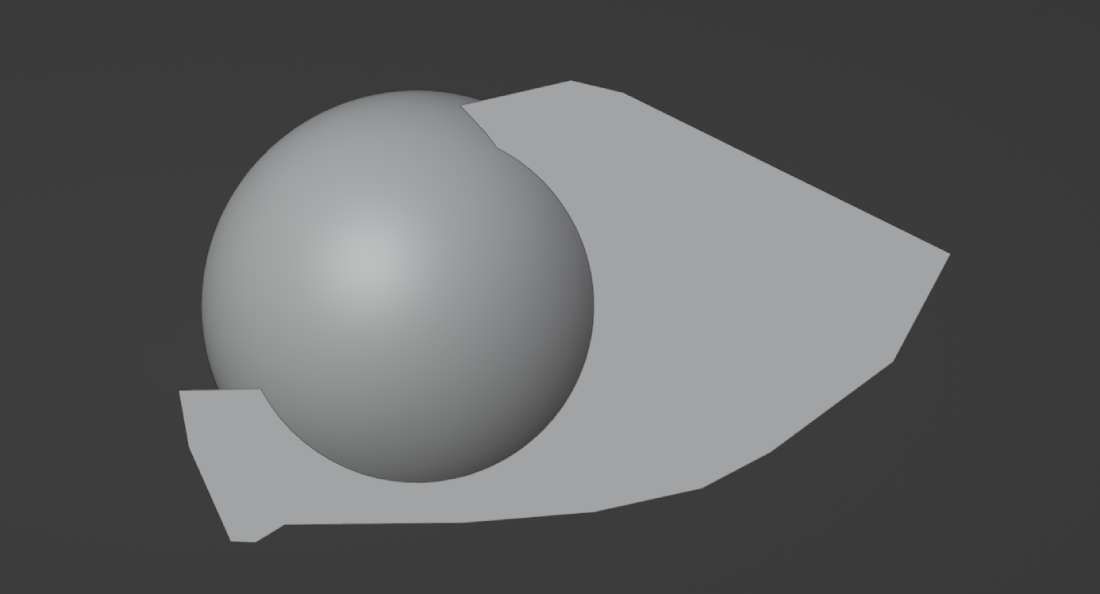
2.4.3
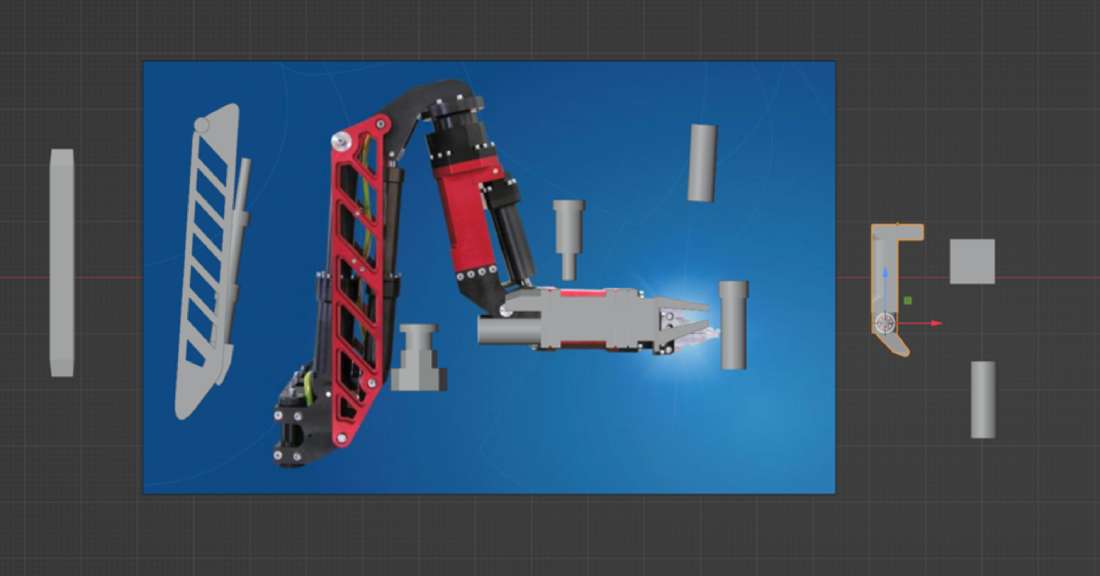
2.4.4
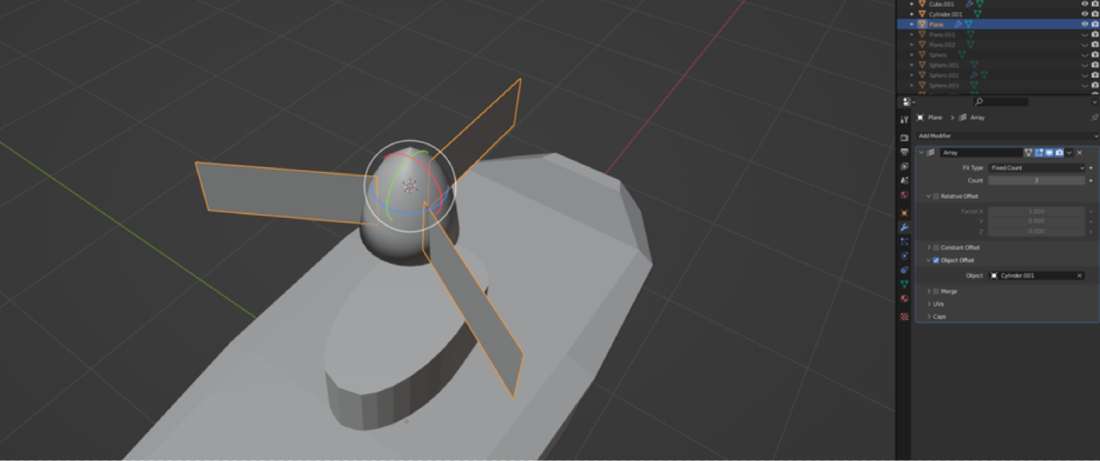
2.4.5
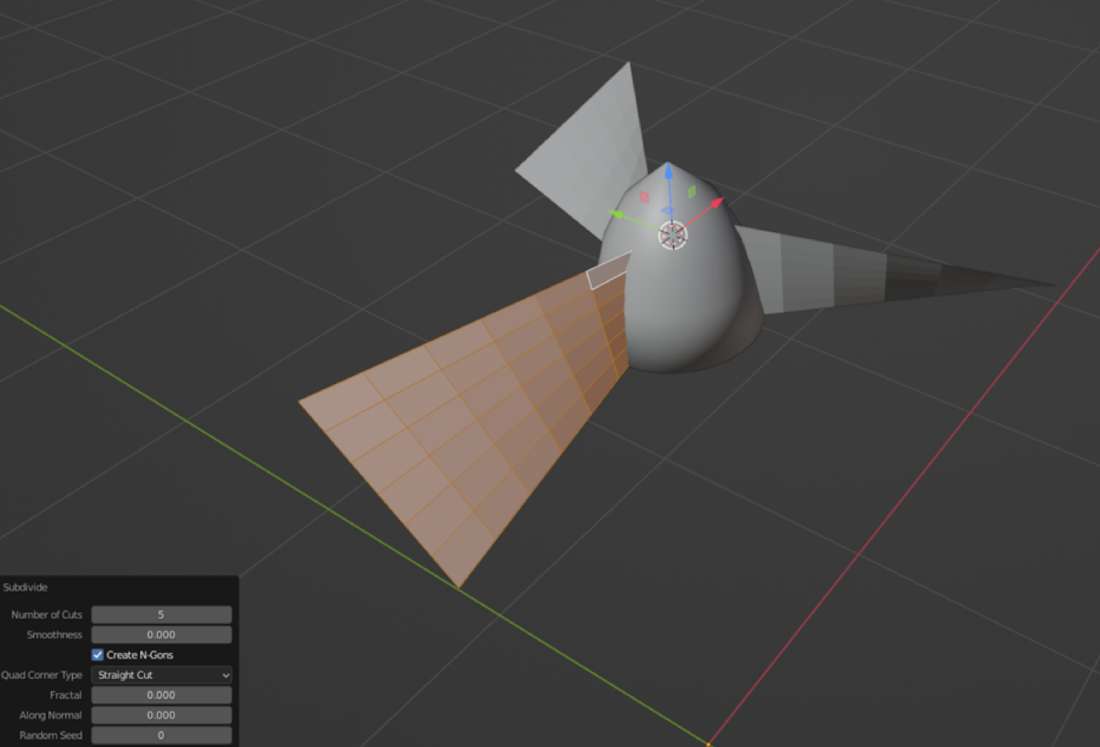
2.4.6
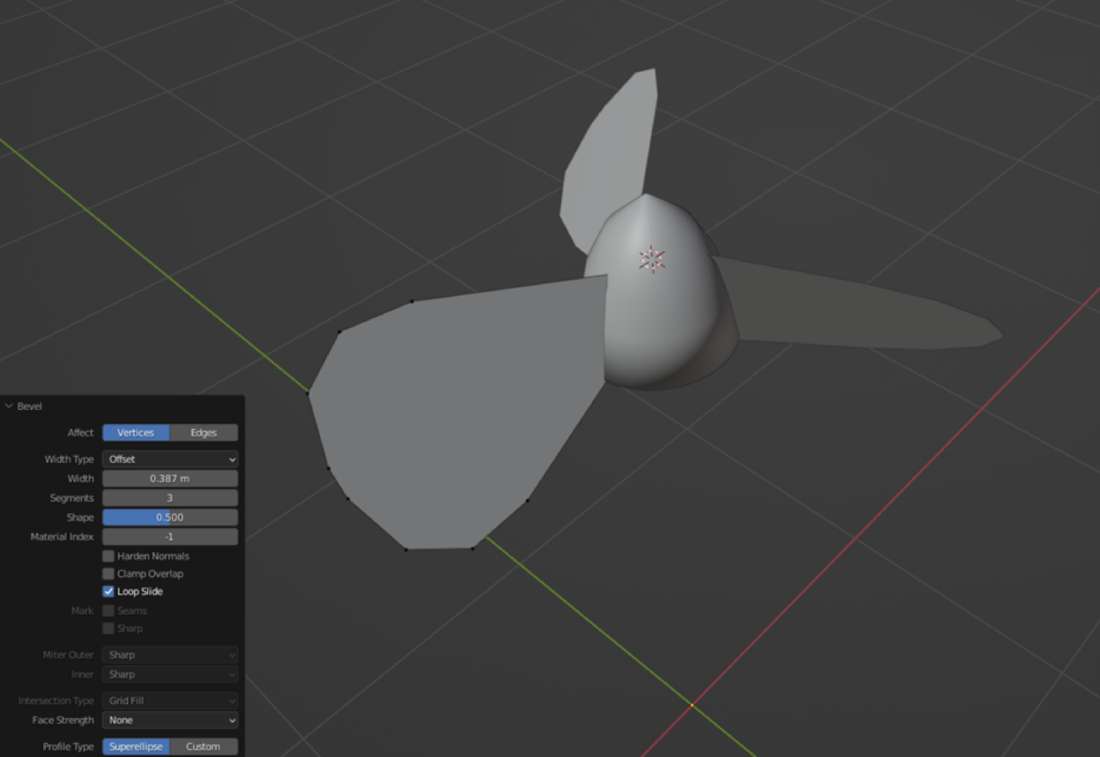
2.4.7
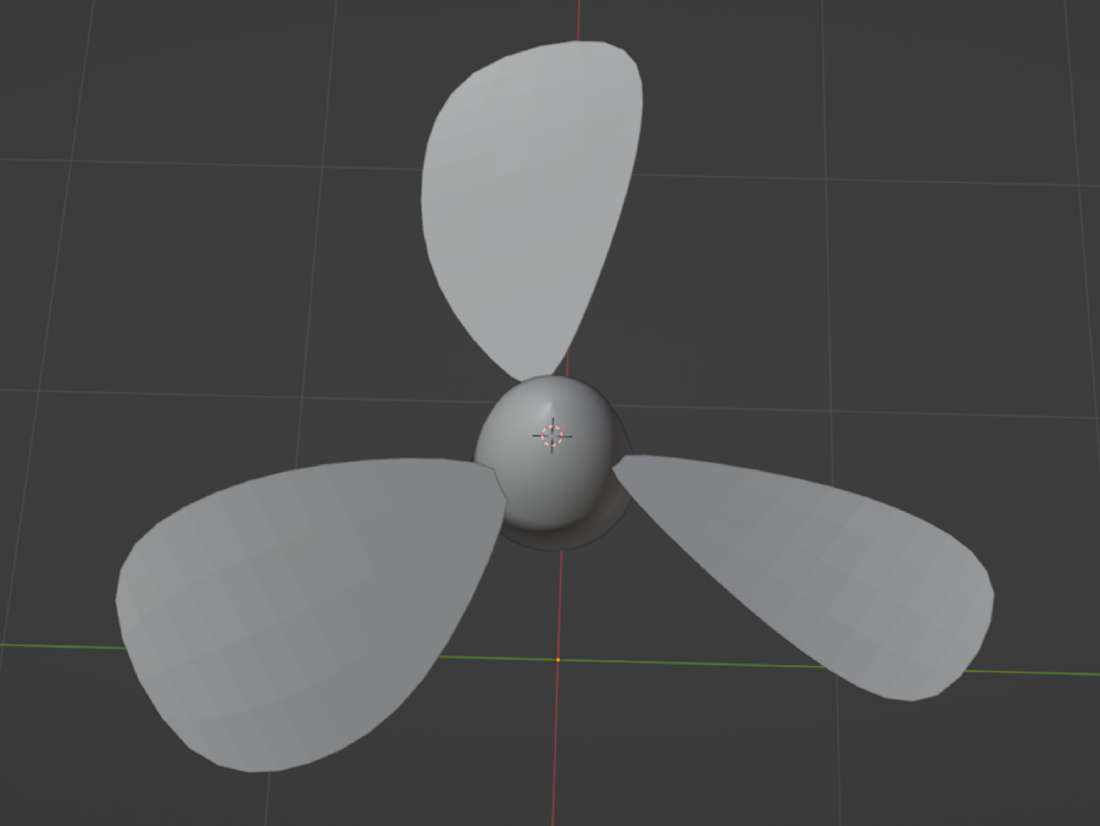
2.4.8
2.5 Lighting
As lighting is possibly the most important influential factor of any scene I wanted to make it perfect. Godrays and shadows are a great ways to enhance the atmosphere just as on the reference image I took on a dive. (2.5.1) It was tricky to get it right but I am happy with the result. I made a light cookie with the below steps. (2.5.2)
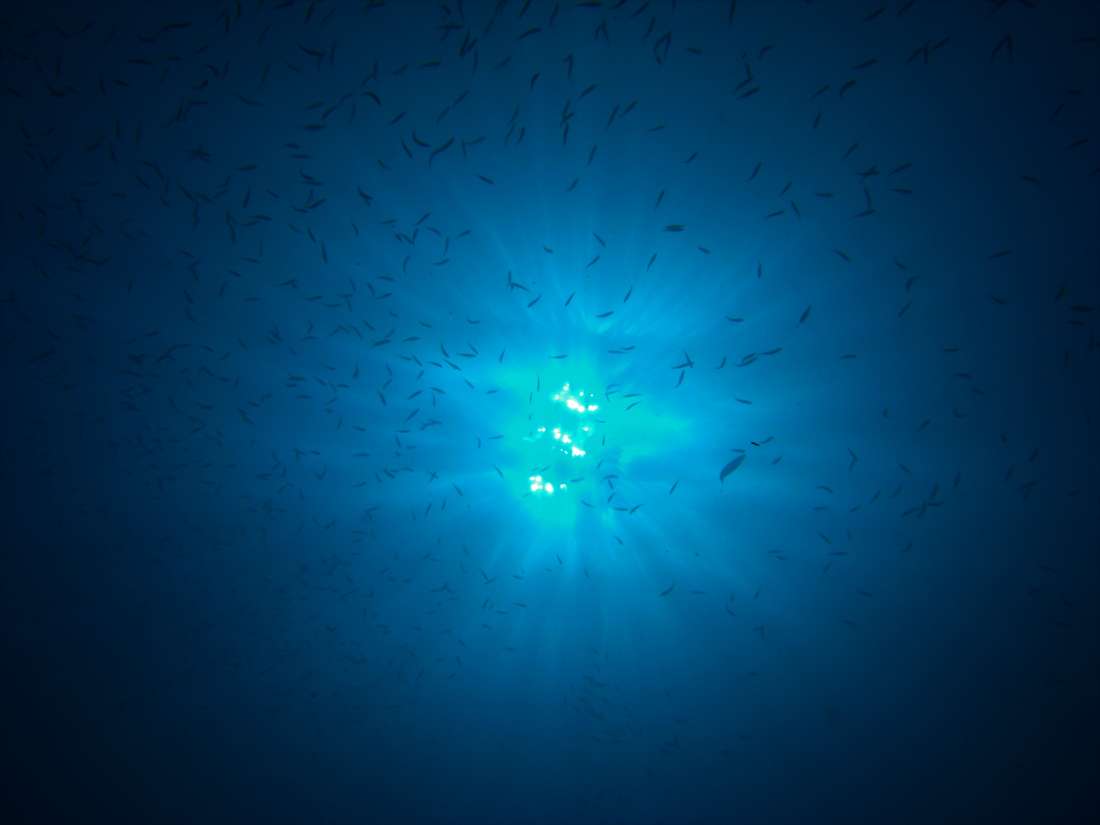
2.5.1
2.5.2
2.6 Animating Fish
A little tricky and time consuming process was animating the fish. Started with adding a wave modifier. Played around with the alignment in order for the modifier to work properly. Next I set origin to one of the vertices on the front of the head so the wave emitted from that point. Highlighted the vertex, pressed SHIFT+S then cursor to selected. In object mode RMB click and set origin to 3D cursor. Next motion needed to be set only to x coordinate then ticked Cyclic for multiple wave generation. For each species I set wave height, width and narrowness for wave size and frequency separately so the motion was proportionate to fish size. Also adjusted stat position to 41 to avoid the head being included in the wave. Finally made a few copies of each species and modified some of these setting. This helped to avoid a uniform look and made fish schools appear more natural.

2.6.1
2.7 Fish Particle System
I tried to utilize the particle system to animate schools similar to their natural swim and swarm patterns. (2.7.1) I changed the physics to Boids. Added the follow the leader boid brain rule. Placed an empty on the scene then within the particle system's render options adjusted render as halo to collection. Finally modified the instance collection to barracudas. (2.7.2)
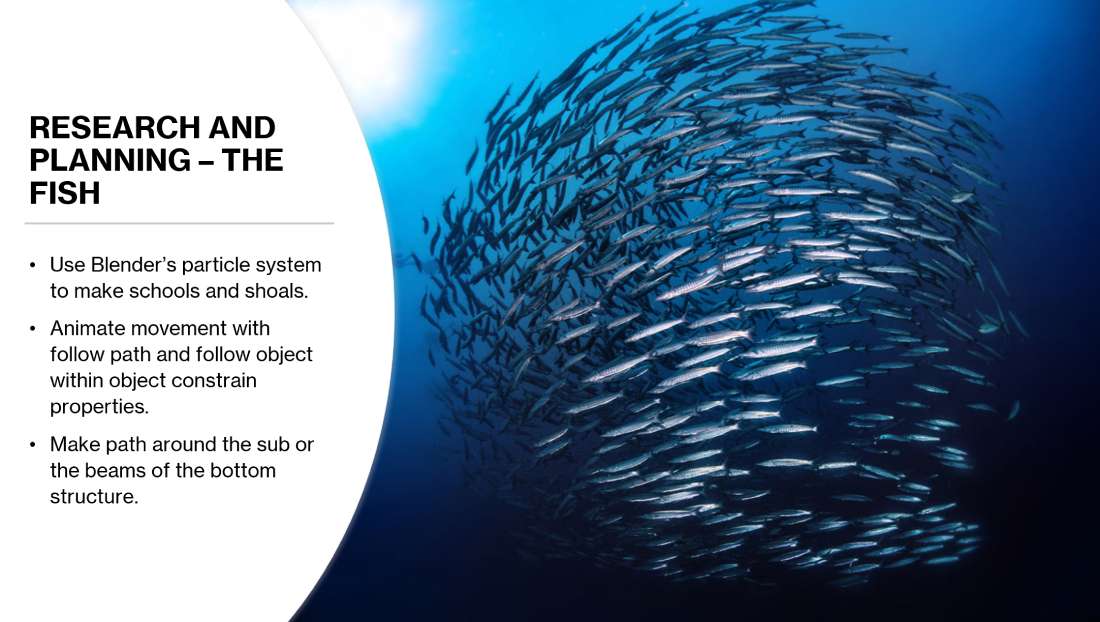
2.7.1
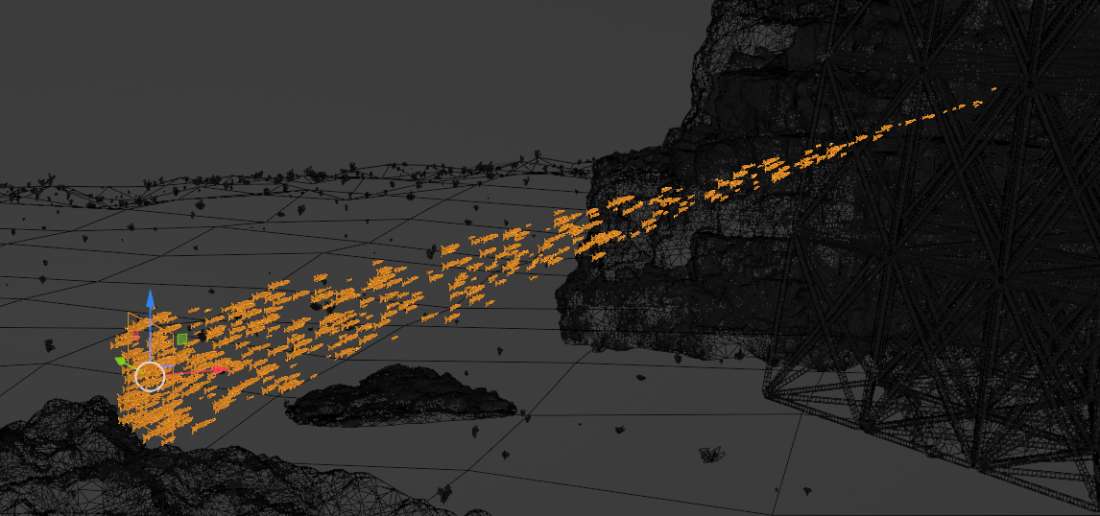
2.7.2
2.8 Composition
As per my lecturer's advice I experimented with alternative ways to find the best position for the camera. First I started to build a small scale model of the scene from wooden sticks however the wood glue I used took an eternity to dry. I decided to revert back to convential methods and made a crude blockout of the scene.(2.8.1) I tried various angles and camera settings till I was pleased with the outcome.
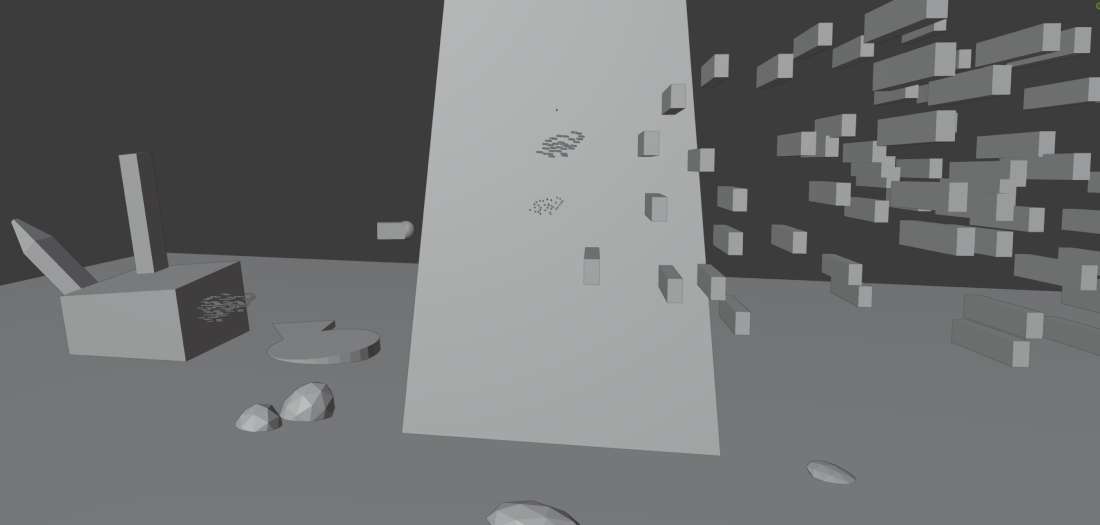
2.8.1
2.9 Project Timeline
The RSA project's two assignments for the two different moduls run parallel through the 1st semester. It took some time until I came up with the idea for both projects hence I started the 3d work later than I would have prefered. Regardless I felt I made good progress up until week 11. Unfortunately personal reasons delayed my progress by more than two weeks and the 10 day extension although did help but was not enough to complete the project. Given the lenghty pause my less than ideal time management skill just further deteriorated the situation. Two gant charts represent the two modul timelines. (2.9.1 and 2.9.2)
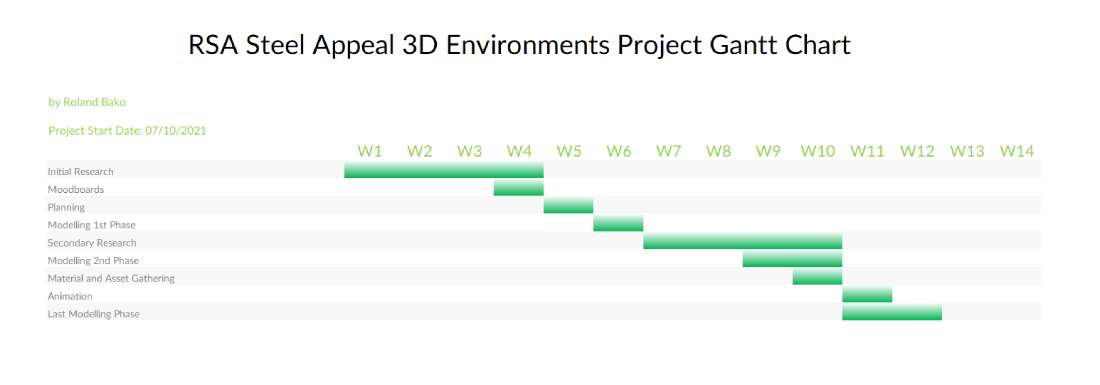
2.9.1
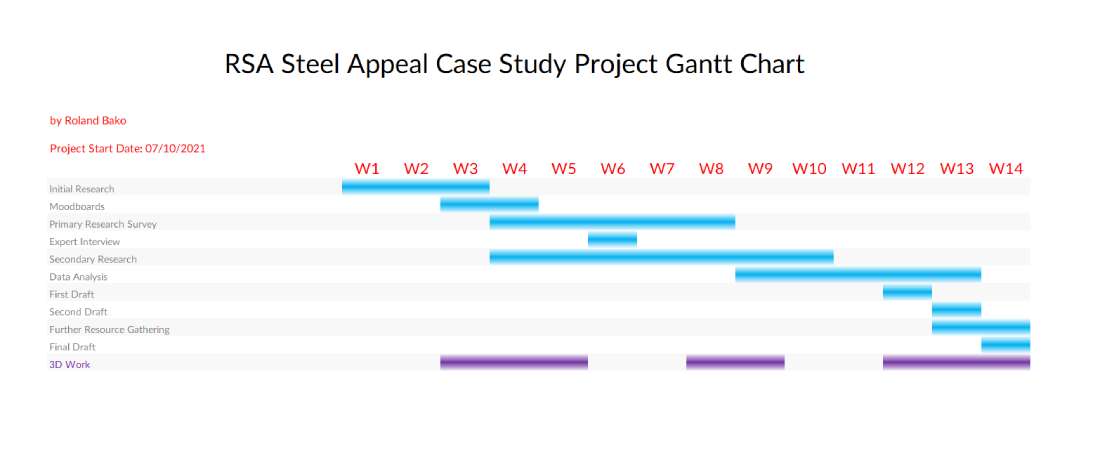
2.9.2
3.0 Conclusion
I am proud of the work I managed to finish. Working simultaneously on an academic and an artistic project proved to be time consuming and exciting. I will pay extra attention to my time management in the future allocating more time to various tasks and assign more instances for unforseen circumstances.
I experimented with numerous new techniques in Blender and gained familiarity with Photopea a rather Photoshop like software and ApowerRec a screen recording application.
I am looking forward to try my newly gained skills in the next semester and in upcoming projects.
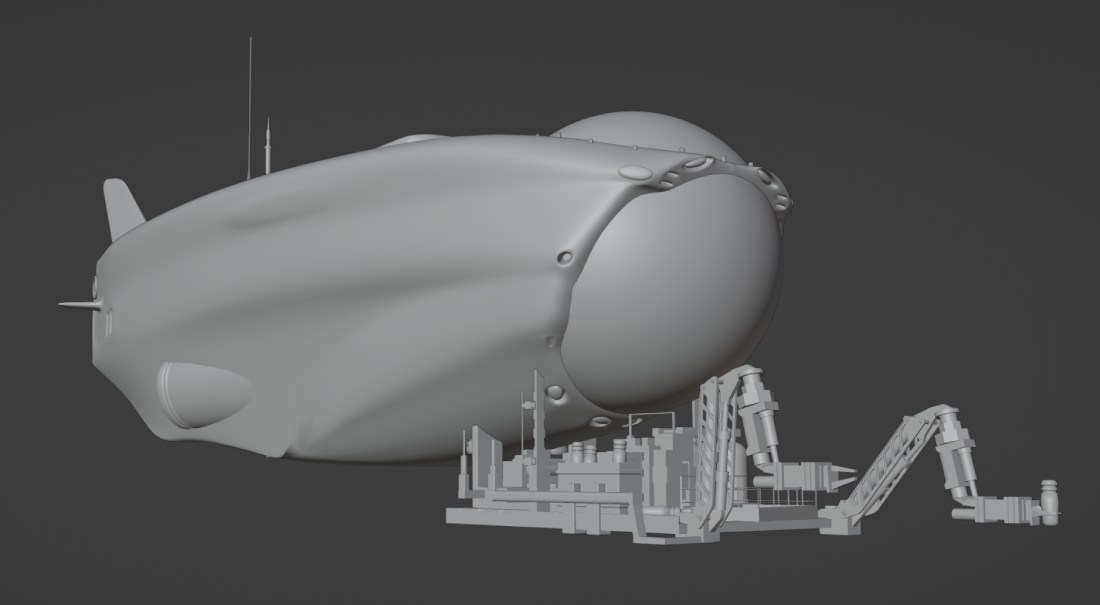
3.0.1
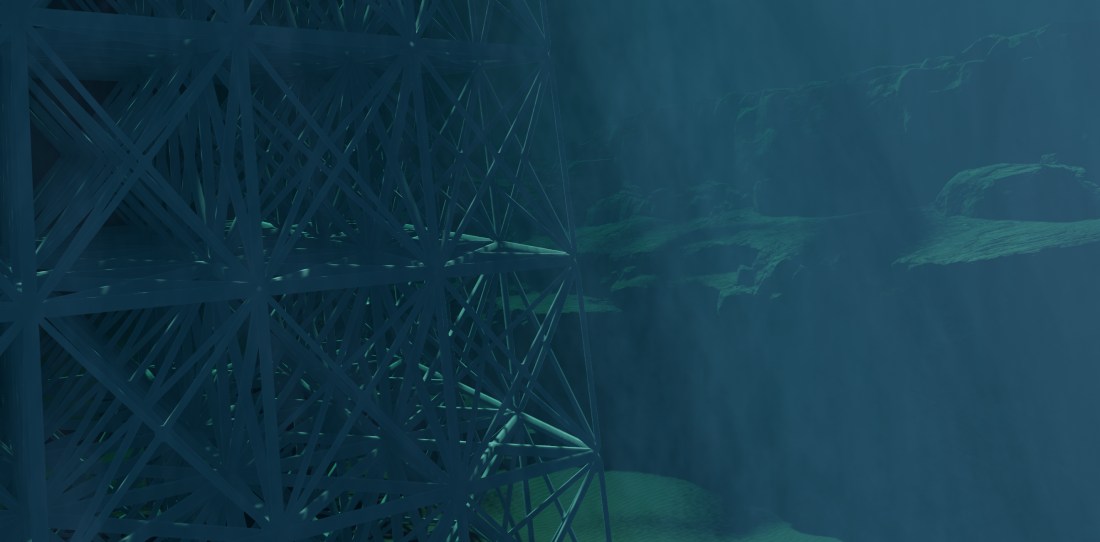
3.0.2
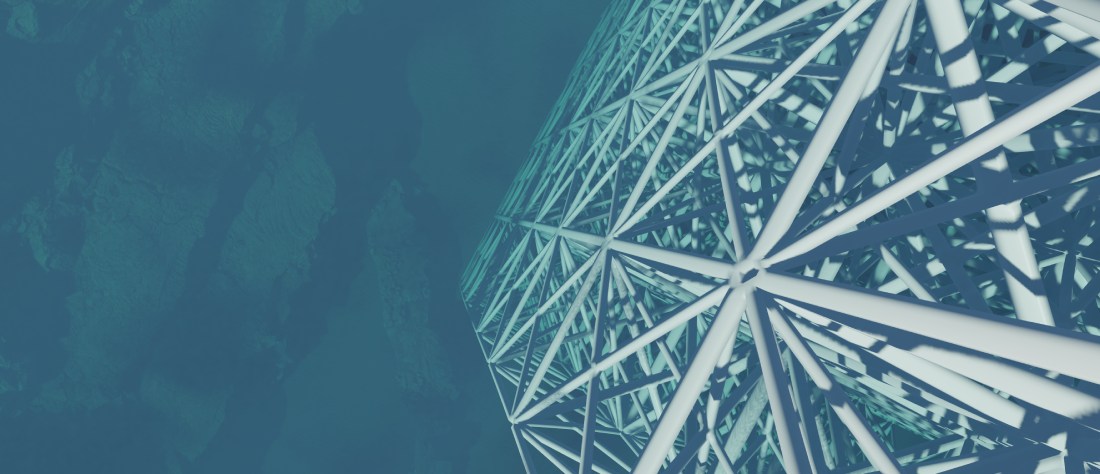
3.0.3
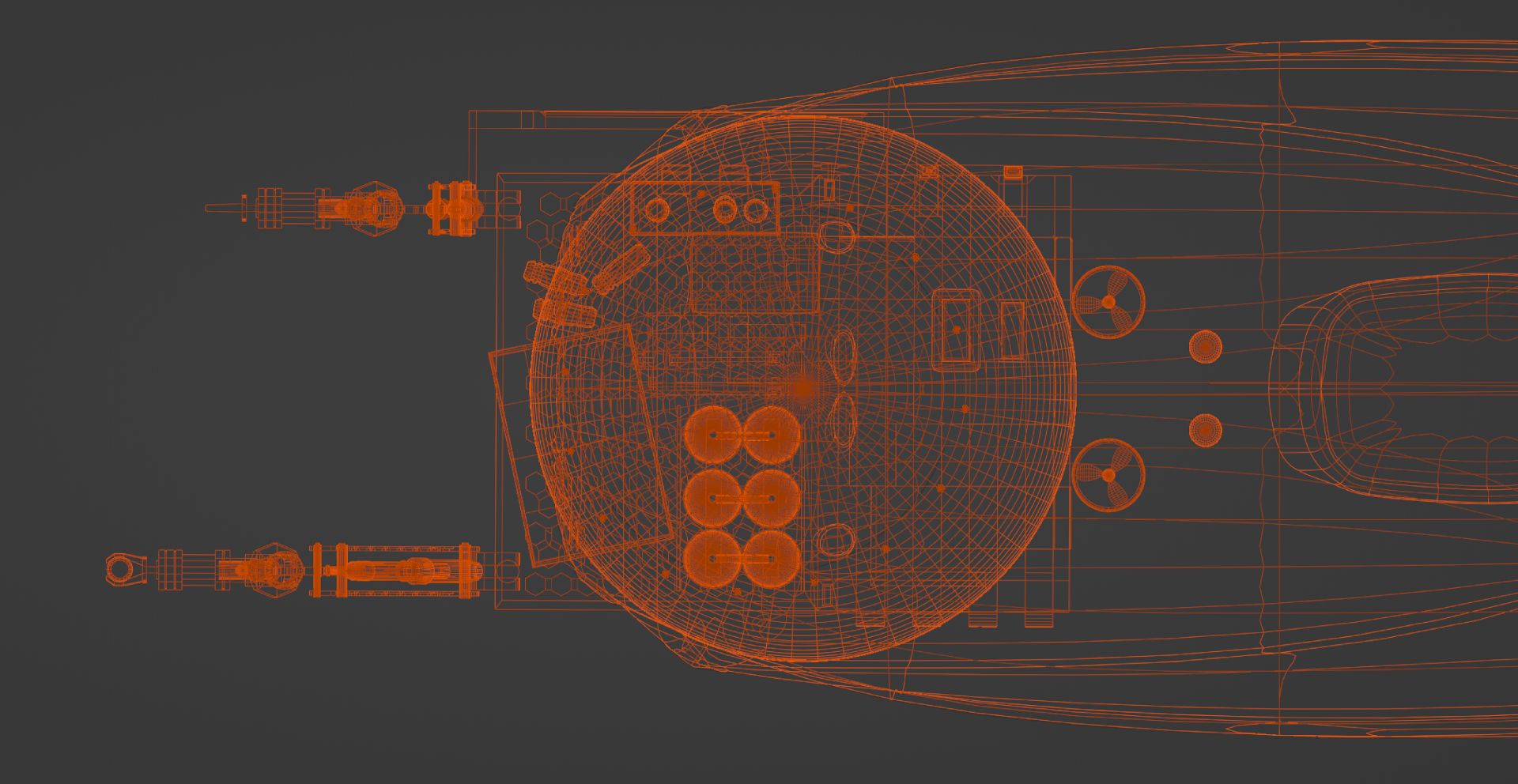
3.0.4
3.0.5